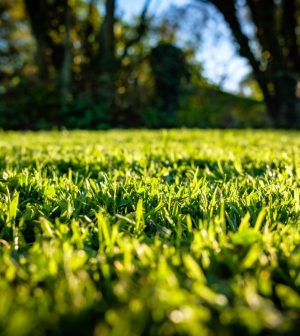- Skip Storing This Everyday Product in the Fridge Door
- Green Tea + B3 Pairing May Boost Brain Health
- Navigating Your Midlife Crisis: Embracing New Possibilities
- City Raccoons Showing Signs of Domestication
- Mapping the Exposome: Science Broadens Focus to Environmental Disease Triggers
- One Week Less on Social Media Linked to Better Mental Health
- Your Brain Changes in Stages as You Age, Study Finds
- Some Suicide Victims Show No Typical Warning Signs, Study Finds
- ByHeart Formula Faces Lawsuits After Babies Sickened With Botulism
- Switch to Vegan Diet Could Cut Your Greenhouse Gas Emissions in Half
1 in 4 U.S. Yards May Have Unsafe Levels of Lead

The yards of 1 in every 4 U.S. households have soil lead levels that exceed new federal lead screening levels of 200 parts per million (ppm), a new study finds.
“I was shocked at how many households were above the new 200 ppm guideline,” said Gabriel Filippelli, a biochemist at Indiana University who led the new study. “I assumed it was going to be a more modest number.”
“The results for the 100 ppm guideline are even worse,” he added. The EPA has set a 100 ppm guideline for households with lead exposures thought to be from multiple sources.
About 29 million U.S. households could be contaminated by soil lead levels that exceed the new EPA guidelines.
The price tag for remediating all of those lead-contaminated yards, using “dig-and-dump” soil-removal methods, could exceed $1 trillion, the study authors estimated.
Lead is an environmental toxin that in much of the 20th century was ubiquitous in gasoline, paint, plumbing and other products. It’s a heavy metal that accumulates in the body and has potentially severe neurological effects, especially for children.
For years, the EPA had set a level of 400 ppm of lead in soil, but in January it lowered that guideline to 200 ppm. Some states have lowered that number even further, with California setting its lowest screening level at 80 ppm.
Decades of slow, steady contamination of air, water and soil mean the challenge to rid the environment of lead is enormous.
“The scale [of the problem] is astounding, and the nation’s lead and remediation efforts just became substantially more complicated” with the new EPA guideline, the study authors said.
Their findings come from a database of soil samples from almost 16,000 residents across the contiguous United States.
They found that about a quarter of yards in the sample exceeded the 200 ppm level. That’s compared to about 12% of yards that exceeded the older EPA guideline of 400 ppm.
The findings were published June 18 in the journal GeoHealth.
How should property owners go about ridding their yards of lead?
The traditional method has been to dig up and cart away the contaminated soil. But interventions like that are expensive and typically only occur after the property has been placed on the National Priority List for remediation, an effort that can take years, Filippelli’s team said.
Ridding all U.S. households of excess lead in this way would cost anywhere from $290 billion to $1.2 trillion, they estimated.
A cheaper solution — one already used by many a backyard gardener — is “capping,” where homeowners bury the contaminated soil under about a foot of soil or mulch.
“Urban gardeners have been doing this forever anyway, with raised beds, because they’re intuitively concerned about the history of land use at their house,” Filippelli explained in a journal news release.
“A huge advantage of capping is speed. It immediately reduces exposure,” Filippelli said. “You’re not waiting two years on a list to have your yard remediated while your child is getting poisoned. It’s done in a weekend.”
How long capping remains a solution to the lead-toxicity problem is unclear, the researcher said, and his team plan to examine that in future research.
In the meantime, despite the challenges, “I’m really optimistic,” Filippelli said. “Lead is the most easily solvable problem that we have. We know where it is, and we know how to avoid it. It’s just a matter of taking action.”
More information
Find out more about lead in the environment at the World Health Organization.
SOURCE: American Geophysical Union, news release, June 18, 2024
Source: HealthDay
Copyright © 2025 HealthDay. All rights reserved.










